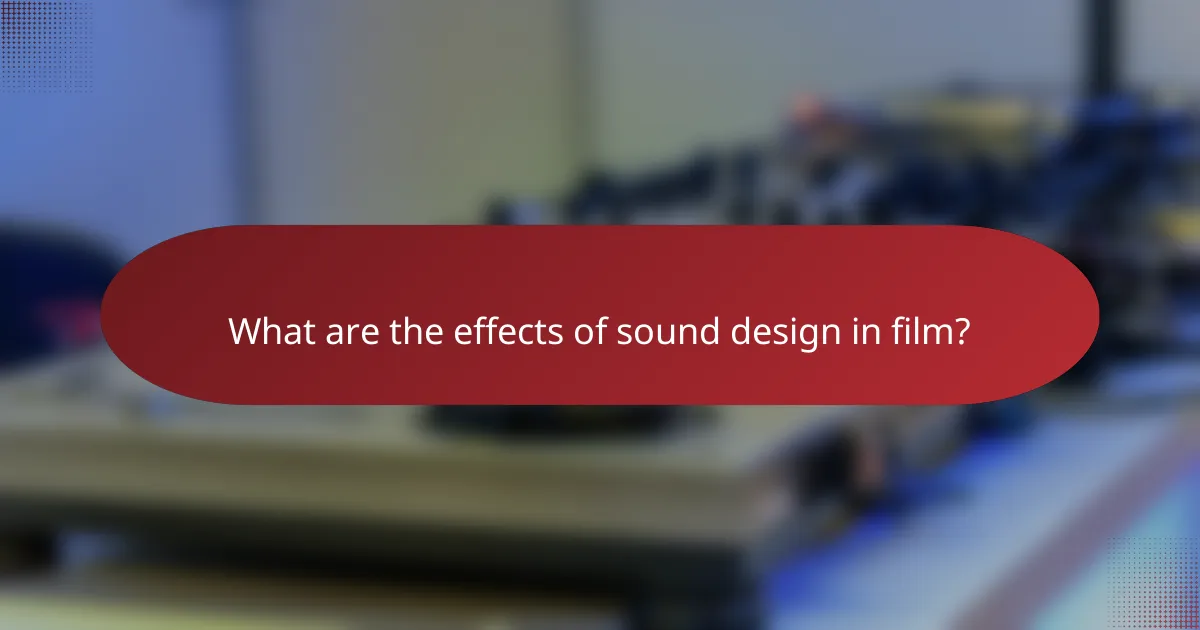Sound design is a vital component in various media, significantly shaping the audience’s emotional response and engagement. By utilizing different types of sound effects, such as Foley sounds and ambient noise, creators can enhance narratives and create immersive experiences in film and video games. The impact of sound design extends beyond mere auditory pleasure, influencing how stories are perceived and felt by audiences.

What are the effects of sound design in film?
Sound design in film significantly influences the overall viewing experience by shaping emotions, enhancing narratives, and creating immersive environments. Its effects can be seen in how audiences react to scenes, perceive characters, and engage with the story.
Emotional impact on audiences
Sound design plays a crucial role in eliciting emotional responses from viewers. By using specific audio elements like music, sound effects, and silence, filmmakers can evoke feelings such as joy, fear, or sadness. For instance, a suspenseful score can heighten anxiety during a tense scene.
Effective sound design can amplify the emotional weight of a moment, making it more memorable. A well-timed sound effect or a poignant musical cue can resonate deeply, often lingering in the audience’s mind long after the film ends.
Enhancement of storytelling
Sound design enhances storytelling by providing context and depth to the narrative. Background sounds, such as ambient noise or character dialogues, help establish the setting and mood, guiding the audience’s understanding of the story. For example, the sound of a bustling city can immerse viewers in an urban environment.
Additionally, audio cues can foreshadow events or highlight critical plot points. Subtle sound elements can signal impending danger or reveal character intentions, enriching the storytelling experience.
Creation of immersive experiences
Immersive experiences in film are largely achieved through sound design, which envelops the audience in the film’s world. Techniques such as surround sound and spatial audio create a three-dimensional soundscape, making viewers feel as though they are part of the action. This can be particularly effective in genres like horror or adventure.
Using realistic sound effects that match the visuals enhances believability. For instance, the sound of footsteps on gravel or the rustle of leaves can transport viewers into the scene, making the experience more engaging and lifelike.
Influence on pacing and tension
Sound design significantly influences the pacing and tension of a film. By manipulating audio elements, filmmakers can control the rhythm of a scene, either accelerating or slowing down the narrative flow. For example, a fast-paced score can create urgency, while slower, drawn-out sounds can build suspense.
Strategically placed sound effects can punctuate moments of tension, making them more impactful. A sudden loud noise can startle viewers, while silence can create a sense of foreboding, effectively heightening the emotional stakes.
Character development through audio cues
Audio cues are essential for character development, providing insights into personalities and motivations. Unique sound motifs associated with specific characters can enhance their identity and make them more memorable. For instance, a character might have a distinct musical theme that reflects their emotional state or journey.
Moreover, the use of voice modulation or sound effects can indicate a character’s internal struggles or transformations. Subtle changes in audio can signal shifts in a character’s mindset, allowing audiences to connect more deeply with their arcs.

How is sound design used in video games?
Sound design in video games enhances the overall experience by creating an immersive environment, providing feedback for player actions, and adapting music to gameplay. It plays a crucial role in engaging players and conveying the game’s atmosphere and narrative.
Environmental audio for realism
Environmental audio includes background sounds that reflect the game world, such as wind, water, and wildlife. This type of sound design helps to establish a sense of place and realism, making the virtual environment feel more alive. For example, a forest setting might feature rustling leaves, distant animal calls, and flowing streams to immerse players in the experience.
To effectively use environmental audio, consider layering different sound elements to create depth. Use spatial audio techniques to position sounds accurately in the 3D space, enhancing the player’s perception of distance and direction.
Feedback sounds for player actions
Feedback sounds provide immediate auditory responses to player actions, reinforcing their decisions and enhancing gameplay. For instance, a successful hit in a combat game might be accompanied by a satisfying sound effect, while a missed shot could feature a different, less rewarding sound. This feedback helps players understand the consequences of their actions.
When designing feedback sounds, ensure they are distinct and easily recognizable. Avoid overwhelming players with too many sounds at once; instead, prioritize clarity and relevance to the action taking place.
Dynamic music that adapts to gameplay
Dynamic music changes in response to gameplay events, enhancing emotional engagement and tension. For example, music might intensify during a boss fight or shift to a calmer theme when exploring. This adaptability keeps players emotionally invested and can influence their performance.
To implement dynamic music effectively, use a system that triggers different music layers or transitions based on gameplay states. Consider using middleware tools that allow for real-time adjustments to the score, ensuring a seamless integration with the game’s mechanics.
Voice acting and character immersion
Voice acting adds depth to characters and storytelling, making the game world more relatable. High-quality voice performances can convey emotions and personality traits, enhancing player connection to the narrative. For instance, a well-acted protagonist can evoke empathy and investment in their journey.
When incorporating voice acting, prioritize casting skilled voice actors who can deliver authentic performances. Ensure that dialogue is well-written and fits the character’s context, as this will significantly impact the player’s immersion and overall experience.

What types of sound effects are commonly used?
Commonly used sound effects include Foley sounds, ambience, soundscapes, and special effects. Each type serves a unique purpose in enhancing audio experiences, contributing to realism, emotional engagement, and dramatic storytelling.
Foley sounds for realism
Foley sounds are everyday noises created in post-production to enhance realism in film and video. These sounds include footsteps, rustling clothes, and object interactions, which are recorded in sync with the visuals to create a believable auditory environment.
When using Foley, consider the context of the scene. For instance, the sound of footsteps on gravel will differ from those on a wooden floor. Recording in a controlled environment helps maintain clarity and consistency.
Ambience for setting the scene
Ambience refers to the background sounds that establish the setting of a scene, such as city noise, nature sounds, or indoor environments. These sounds create a sense of place and can significantly influence the viewer’s perception of the scene.
To effectively use ambience, layer different sound elements to create depth. For example, a forest scene might include birds chirping, leaves rustling, and distant animal calls. Adjust the volume levels to ensure the ambience supports rather than overwhelms dialogue or action.
Soundscapes for emotional depth
Soundscapes are intricate audio compositions that evoke specific emotions or moods. They combine various sound elements, including music, effects, and natural sounds, to create a rich auditory experience that resonates with the audience.
When crafting soundscapes, consider the emotional arc of the scene. For instance, a tense moment might feature dissonant sounds and low frequencies, while a serene scene could utilize soft melodies and gentle nature sounds. Experiment with layering to achieve the desired emotional impact.
Special effects for dramatic impact
Special effects are unique sounds designed to create dramatic moments or highlight specific actions, such as explosions, magical spells, or sci-fi elements. These effects often require creative sound design techniques to achieve the desired impact.
To effectively implement special effects, ensure they align with the visual elements and overall tone of the project. Use high-quality recordings and consider the spatial placement of sounds to enhance immersion. Avoid overusing effects, as this can diminish their impact and distract the audience.

What are the best practices for sound design?
Best practices in sound design focus on creating immersive audio experiences by carefully considering the elements of sound layering, silence, and context. Effective sound design enhances storytelling and engages the audience, making it essential to apply these techniques thoughtfully.
Layering sounds for complexity
Layering sounds involves combining multiple audio elements to create a richer and more textured soundscape. This technique can enhance realism and emotional impact, as different layers can represent various aspects of a scene or environment.
When layering sounds, consider the frequency spectrum to avoid muddiness. Aim for a balance where each layer contributes without overpowering others. For example, you might layer a soft wind sound with distant birds chirping and subtle rustling leaves to evoke a serene outdoor setting.
Common pitfalls include excessive layering, which can lead to confusion, and neglecting the spatial placement of sounds. Use panning and volume adjustments to create a sense of depth and directionality in your audio mix.
Using silence effectively
Silence can be a powerful tool in sound design, serving to heighten tension, emphasize moments, or create contrast. By strategically incorporating silence, you can draw attention to key audio elements or narrative points.
To use silence effectively, consider the pacing of your audio. A brief pause before a significant sound can amplify its impact, while longer silences can build suspense. For instance, in a horror film, a sudden silence followed by a loud noise can startle the audience.
Avoid overusing silence, as it can disrupt the flow of your audio experience. Instead, use it purposefully to enhance storytelling and maintain audience engagement. Aim for a balance that complements the overall sound design without detracting from it.










